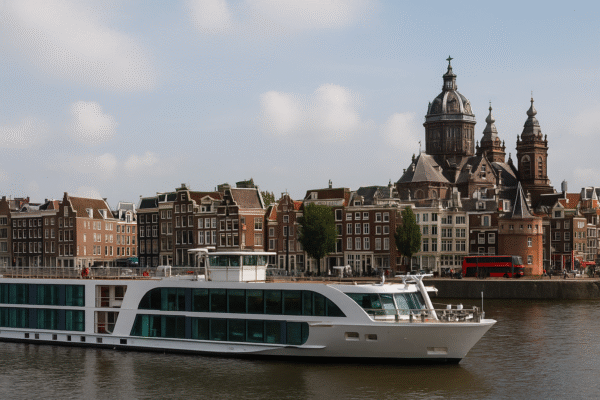Amsterdam is preparing to ban all cruise ship traffic by 2035, a decisive step in its multi-year effort to fight overtourism, reduce pollution, and restore the quality of life for its residents. One of Europe’s most iconic and frequently visited cities is thus making a major move to reshape its tourism future. The proposed policy is a direct response to years of local protests and environmental activism calling for greener, more responsible tourism management.
Each year, Amsterdam welcomes more than 20 million tourists, many of whom explore its charming canals, world-class museums, and eclectic neighborhoods. But the sheer volume has increasingly overwhelmed the city’s infrastructure and historic core. The announcement of a cruise ship ban signals a larger shift in the way the city plans to manage tourism and urban space over the next decade.
Why Amsterdam Is Saying “No” to Cruise Ships
The cruise ship ban forms part of Amsterdam’s broader sustainability goals and long-standing concerns about overcrowding, environmental degradation, and the erosion of local quality of life.
1. Overtourism and Congestion
Cruise ships deliver thousands of passengers at a time into the city’s compact center, overwhelming public transit, clogging narrow streets, and creating long queues at key attractions. Nearly 200,000 cruise passengers arrive annually, often staying only a few hours—spending little but leaving behind environmental and social costs.
2. Environmental Impact
Cruise ships contribute heavily to air and water pollution. They burn large quantities of bunker fuel, releasing greenhouse gases and toxic particulates into the air. Additionally, waste runoff and noise pollution threaten Amsterdam’s canals, which are designated as a UNESCO World Heritage Site.
3. Resident Discontent
Locals have grown increasingly frustrated with the scale and style of tourism. Complaints range from noise disruptions and overcrowded transit systems to a loss of cultural authenticity in neighborhoods like De Wallen and Jordaan. The presence of massive cruise liners in a city known for its historic charm has become symbolic of unchecked tourism.
4. Cultural Preservation
Amsterdam is eager to preserve its cultural integrity. Officials believe that mass tourism, particularly from cruise lines, dilutes the city’s character and favors high-volume, low-value tourism over immersive, respectful cultural engagement.
What the 2035 Ban Entails
The 2035 cruise ship ban will eliminate docking rights for ocean-going cruise ships at the Passenger Terminal Amsterdam, which sits just east of the city center. City leaders plan to relocate maritime traffic to ports outside the core, potentially including IJmuiden, a port town farther from the city but with more capacity for green infrastructure.
This change is expected to:
- Reduce maritime emissions near the city center
- Lower the number of day-trip tourists
- Promote longer, more meaningful travel experiences
- Create space for eco-friendly alternatives, such as small-group river cruises and train-based travel itineraries
The final policy framework is expected to be formalized by the end of 2026, providing the cruise industry and tourism stakeholders time to transition.
The “Stay Away” Campaign: Laying the Groundwork
Amsterdam’s move to ban cruise ships follows years of incremental policy shifts. In 2023, the city launched the “Stay Away” campaign, aimed at discouraging rowdy, party-centric tourism—particularly from younger British travelers notorious for stag parties and pub crawls.
Initiatives included:
- Banning cannabis smoking in the Red-Light District
- Cracking down on public drunkenness
- Limiting alcohol sales in tourist zones
- Promoting respectful travel behavior through targeted ads
These campaigns laid the social and political foundation for broader reforms such as the cruise ship ban, reinforcing the city’s stance that sustainable tourism is the only viable future.
What Travelers Can Expect in the Post-Cruise Era
The cruise ship ban is not meant to deter tourism, but to reshape it. Here’s what visitors can expect:
- Less congestion in peak months
- Cleaner air and quieter neighborhoods
- More authentic experiences, with better access to local businesses and cultural institutions
- Increased eco-tourism options, such as sustainable accommodations, walking tours, and slow travel packages
Tourists arriving by train or air will still find a welcoming city—but one focused on longer stays and deeper cultural connection. This model favors travelers who wish to explore Amsterdam with care and curiosity, rather than those looking for a whirlwind photo-op.
Impact on the Cruise Industry and Local Businesses
While the cruise industry may face challenges adapting to the shift, local businesses could benefit from a more stable, quality-focused tourism economy. Restaurants, museums, hotels, and tour operators are likely to see increased engagement from slower, more intentional visitors who spend more time—and money—within the city.
Small businesses particularly stand to gain from a decrease in fast-moving, cruise-driven day trippers. Extended-stay travelers are more likely to explore beyond the city center, spreading tourism revenue to areas like Amsterdam-Noord, Oost, and the surrounding Dutch countryside.
Amsterdam as a Model for Sustainable Urban Tourism
Amsterdam’s cruise ship ban is not an isolated policy—it’s part of a global movement. Cities like Venice, Barcelona, and Santorini are grappling with similar overtourism issues and may soon follow Amsterdam’s lead.
The Dutch capital’s efforts are already being watched as a test case for balancing urban livability with economic vitality. With bold political will, clear timelines, and community support, Amsterdam is showing how global cities can reclaim space for residents, reduce environmental damage, and reimagine tourism as a force for good.
Conclusion: A Greener Horizon for Amsterdam
As the world’s travel habits evolve post-pandemic, Amsterdam is choosing sustainability over scale. The 2035 cruise ship ban is a pivotal moment in this journey—an opportunity for the city to emerge as a leader in responsible, climate-conscious urban tourism.
For travelers, this means a more authentic Amsterdam: less crowded, less polluted, and more connected to its roots. For global tourism, it’s a blueprint that challenges other destinations to rethink their own approach to balancing economic benefits with long-term livability.
Stay updated, read more travel news from Global Travel Wire.
Disclaimer:
This image is AI-generated and created for illustrative purposes only. It may not accurately represent the actual events, individuals, or locations described in the news article.

















